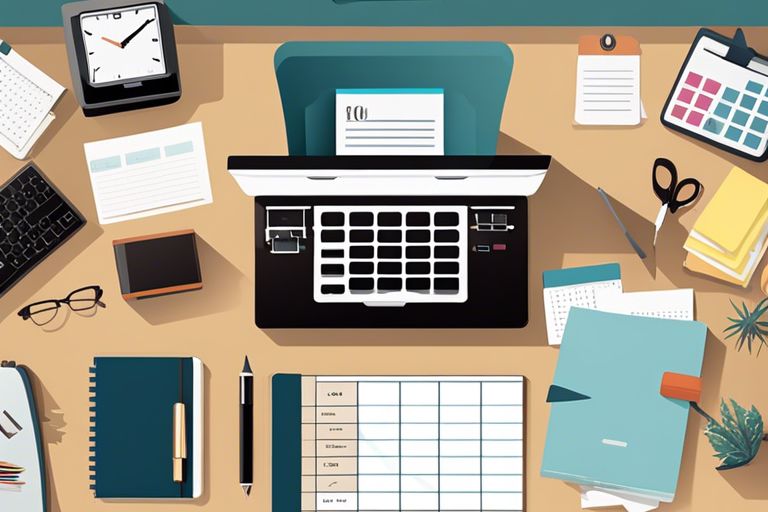Are you struggling to transform your home routine into a balanced lifestyle? Look no further! In this article, we will provide you with essential time management tips at home to help you maximize productivity. By implementing these strategies, you can optimize your routine and make the most of your valuable time. So, let’s dive in and discover how you can achieve an efficient and balanced lifestyle.
Assessing Your Responsibilities: Creating a Weekly Planner
Before implementing effective time management strategies, it is important to assess your responsibilities and create a weekly planner. By taking the time to evaluate all your tasks and commitments, you can gain a clear understanding of your obligations and allocate your time accordingly. This step is crucial in improving your time management skills and maximizing productivity.
Start by listing all your responsibilities, both personal and professional, and categorize them based on urgency and importance. This will help you prioritize tasks and ensure that important deadlines are met. Consider the time available to you throughout the week and allocate specific time slots for each task. Be realistic in your planning, allowing for breaks and unexpected interruptions.
Creating a visual representation of your weekly planner can be helpful in providing a clear overview of your schedule. You can use a digital calendar or a physical planner to map out your days and allocate time blocks for different tasks. This will not only help you stay organized but also serve as a visual reminder of your commitments and deadlines.
Table: Example Weekly Planner
| Day | Time Slot | Task |
|---|---|---|
| Monday | 9:00 AM – 10:30 AM | Project A |
| Monday | 10:30 AM – 11:00 AM | Break |
| Monday | 11:00 AM – 12:30 PM | Meeting with Team B |
| Tuesday | 8:30 AM – 9:30 AM | Exercise |
| Tuesday | 9:30 AM – 11:30 AM | Project B |
| Tuesday | 11:30 AM – 12:00 PM | Break |
| Wednesday | 9:00 AM – 10:00 AM | Client Call |
| Wednesday | 10:00 AM – 12:00 PM | Project C |
Remember that a weekly planner is a flexible tool that allows for adjustments and refinements as needed. Regularly review and update your planner to accommodate changes in your priorities and unforeseen circumstances. By consistently assessing your responsibilities and creating a well-structured weekly planner, you can effectively manage your time, improve productivity, and achieve a better work-life balance.
Establishing Organization: Putting Things Back in Their Place
One common time management challenge at home is maintaining organization. To optimize your time, it is crucial to implement a system where everything is put back in its designated place. This ensures that you can easily find items and avoid wasting time searching for them. By creating a habit of putting things back where they belong, you can improve efficiency and save valuable time.
Implementing a new system of organization can initially require some effort and adjustment. Start by decluttering and organizing your spaces to create designated areas for different items. Use storage solutions such as shelves, bins, or drawers to keep items organized and easily accessible. Label containers or use color-coding systems to further enhance organization and streamline the process.
When you finish using an item, make it a habit to immediately put it back in its designated place. This simple action prevents clutter from accumulating and ensures that everything has a home. It may take some time to develop this habit, but with consistency and perseverance, it will become second nature.
Benefits of Establishing Organization:
| Improved Efficiency | Reduced Stress | Time Savings |
|---|---|---|
| With a well-organized space, you can quickly locate items when you need them, eliminating the time spent searching. | A clutter-free environment reduces stress and promotes a sense of calmness and productivity. | By putting things back in their designated places, you avoid wasting valuable time looking for misplaced items. |
| Enhanced Productivity | Improved Focus | Streamlined Daily Routine |
| With a clear and organized workspace, you can focus better on your tasks and accomplish them more efficiently. | Eliminating visual clutter allows you to concentrate on the task at hand and avoid distractions. | Putting things back where they belong creates a streamlined daily routine, ensuring that you can easily find and access the items you need. |
By establishing organization and putting things back in their place, you can create a more efficient and productive environment at home. This simple yet effective time management strategy will help you avoid wasting time searching for misplaced items and reduce stress in your daily life. Embrace the benefits of organization and enjoy the time savings it brings.

Creating a Landing Strip: Streamlining Daily Essentials
When it comes to managing your time effectively at home, creating a “landing strip” can be a game-changer. A landing strip is a designated area near the entrance of your home where you can store and organize your daily essentials. By streamlining your essentials in one easily accessible location, you can save time, reduce stress, and start your day on the right foot.
The landing strip should be well-organized and tailored to your specific needs. Consider including hooks for keys, a tray or bowl for small items like wallets and phones, and a designated spot for important documents or mail. Having a dedicated space for these essentials ensures that you always know where to find them, eliminating the need for frantic last-minute searches.
By implementing a landing strip, you create a streamlined routine that saves you valuable time each day. Imagine no longer having to rummage through drawers or search high and low for misplaced items. Instead, everything you need is conveniently located in one place, making your morning routine more efficient and stress-free.
Example of a Landing Strip Setup
| Item | Designated Area |
|---|---|
| Keys | Hook by the entrance |
| Wallet | Tray on the landing strip shelf |
| Phone | Charging dock near the entrance |
| Important documents | Filing system on the landing strip shelf |
By following this example, you can customize your landing strip to suit your specific needs. Remember, the goal is to create a space that is not only functional but also visually appealing. A well-organized and aesthetically pleasing landing strip sets the tone for an organized and productive day.

In the next section, we will explore the importance of delegating tasks and sharing the workload to further optimize your time management at home.
Delegating Tasks: Sharing the Workload
Effective time management involves recognizing the importance of delegating tasks to others. By sharing the workload and responsibilities, you can improve productivity and maximize your efficiency. Delegating tasks not only frees up time for more important or high-priority tasks but also allows you to focus on your core competencies and areas of expertise.
When delegating tasks, it is essential to clearly communicate expectations and provide any necessary instructions or guidance. This ensures that the delegated tasks are completed accurately and up to your standards. By sharing responsibilities with others, you create a collaborative environment that fosters teamwork and helps build trust within your household or professional setting.
Benefits of Delegating Tasks
Delegating tasks offers several benefits in terms of effective time management. By assigning tasks to others who are skilled and capable of handling them, you can:
| Benefits of Delegating Tasks |
|---|
| · Increase productivity and efficiency |
| · Share responsibilities and workload |
| · Focus on high-priority tasks |
| · Develop trust and teamwork |
| · Foster a collaborative environment |
| · Enhance overall performance and outcomes |
Delegating tasks is a valuable skill that allows you to leverage the strengths and abilities of others. It not only boosts your own productivity but also helps to develop the skills and capabilities of those you delegate tasks to. When done effectively, delegation becomes an essential tool for effective time management and a key driver for achieving optimal results.

Continuous Improvement: Tweaking and Adapting Your Routine
Continuous improvement plays a vital role in effective time management at home. By regularly reviewing and tweaking your routines, you can increase efficiency and make the most out of your time. It’s essential to adapt your routine based on new insights and experiences to optimize productivity. Let’s explore some strategies to help you continuously improve your time management at home.
Regularly review old routines:
Taking the time to evaluate your existing routines is crucial for identifying areas that can be optimized. Review your daily, weekly, and monthly schedules to assess if they align with your goals and priorities. Look for tasks or activities that may no longer serve a purpose or can be streamlined. By letting go of unnecessary commitments and refining your routines, you can free up time for more meaningful activities.
Experiment and adapt:
Don’t be afraid to try new approaches and experiment with different techniques. Not all strategies work for everyone, so it’s important to find what works best for you. Experimenting allows you to discover new ways to increase efficiency and productivity. Keep an open mind and be willing to adapt your routines based on the results you observe.
Seek feedback:
Don’t hesitate to seek feedback from others who may be affected by your routines. Ask for input from your family members, colleagues, or mentors to gain different perspectives on how you can improve your time management. Their insights may provide valuable suggestions and help you identify blind spots that you may have overlooked.

Incorporating continuous improvement into your time management practices at home allows you to stay proactive and adaptable. By regularly assessing and adjusting your routines, you can increase efficiency, reduce wasted time, and create a more productive and balanced lifestyle.
Harnessing the Power of Early Mornings
Waking up earlier can be a game-changer when it comes to increasing productivity and setting a routine for focused work. By setting your alarm clock a little earlier each day, you create a dedicated time slot for tasks that require your utmost attention. Whether it’s tackling important projects, exercising, or engaging in personal activities, utilizing the early mornings allows you to start your day with a sense of accomplishment and sets a positive tone for the rest of the day.
When you wake up earlier, you have the opportunity to have uninterrupted time for deep work. This uninterrupted time can be incredibly powerful for tackling complex tasks that require concentration and creativity. By eliminating distractions and potential interruptions, you can make significant progress on your most challenging projects and set the tone for a productive day ahead.
Additionally, waking up earlier allows you to establish a consistent routine. Our bodies and minds thrive on consistency, and by waking up at the same time every day, you train your body to naturally wake up at that hour, making it easier to get out of bed and start your day. This regularity also helps regulate your sleep patterns, ensuring you get enough rest each night, and wake up feeling refreshed and ready to take on the day.
Table: Benefits of Waking Up Earlier
| Benefit | Description |
|---|---|
| Increased productivity | Waking up earlier provides dedicated time for focused work, leading to increased productivity throughout the day. |
| Establishing a routine | Waking up at the same time every day helps create a consistent routine that optimizes your body and mind. |
| Focused work time | The early mornings offer an uninterrupted and distraction-free environment for tackling important tasks. |
| Positive mindset | Starting the day with a sense of accomplishment creates a positive mindset that carries over into the rest of your activities. |
By harnessing the power of early mornings, you can set yourself up for success and make the most of your time. Experiment with waking up earlier and find a routine that works best for you. Whether you use this time for work, personal growth, or self-care, the early mornings can become a source of empowerment and productivity in your daily life.

Designating Spaces: Separating Work and Leisure
Creating designated spaces for work and leisure activities is essential for maintaining a healthy work-life balance. When working from home, it can be challenging to separate your professional and personal life, but having distinct spaces for each can significantly improve your mental focus and productivity.
By designating a specific area in your home as your workspace, such as a home office or a corner in a quiet room, you create a consistent environment that triggers a work mindset. This separation helps you mentally switch into work mode when you enter your designated workspace, allowing you to concentrate better and be more productive.
On the other hand, it’s equally important to have spaces dedicated to leisure and relaxation. Creating a cozy corner or a comfortable reading nook where you can unwind and enjoy your hobbies helps promote a clear boundary between work and personal time. This separation allows you to recharge and maintain a healthy work-life balance, preventing burnout and improving overall well-being.
Table: Benefits of Designated Spaces
| Benefits | Work Spaces | Leisure Spaces |
|---|---|---|
| Promotes mental focus | ✓ | |
| Increases productivity | ✓ | |
| Helps maintain work-life balance | ✓ | ✓ |
| Improves overall well-being | ✓ |
Having designated spaces for work and leisure offers several benefits. By promoting mental focus and increasing productivity, workspaces allow you to stay on task and accomplish your professional goals. On the other hand, leisure spaces help you disconnect from work, relax, and enjoy personal activities, improving your overall well-being.
Remember, consistency is key. By consistently using your designated work and leisure spaces, you reinforce the mental association between these areas and their respective activities. This consistency ultimately helps you maintain a healthy work-life balance and optimize your productivity.
Leveraging Productivity Apps: Tools for Efficiency
In today’s fast-paced world, staying organized and managing time effectively is crucial for productivity. Fortunately, there are numerous productivity apps available that can help streamline your tasks and optimize your workflow. By leveraging these powerful tools, you can take control of your time and enhance your overall efficiency.
Project Management
Productivity apps with project management features can be invaluable for keeping track of your tasks and deadlines. These apps allow you to create projects, assign tasks, and set priorities, helping you stay on top of your workload. With visual interfaces and progress-tracking tools, you can easily monitor your project’s status and ensure that you’re meeting your goals in a timely manner.
Task Reminders
Have you ever forgotten a deadline or an important appointment? Task reminder apps can help you avoid these situations by sending you notifications and alerts for upcoming tasks and events. You can set reminders for specific tasks, meetings, or even personal goals, ensuring that nothing slips through the cracks. Whether it’s a gentle notification or a more urgent alert, these apps will keep you on track.
Time Tracking
Understanding how you spend your time is essential for effective time management. Time tracking apps allow you to monitor the time you spend on different activities, providing valuable insights into your productivity habits. With features like detailed reports and visual charts, these apps help you identify areas where you can make improvements and optimize your workflow.
| App | Features | Platform |
|---|---|---|
| Asana | Project management, task assigning, progress tracking | Web, iOS, Android |
| Todoist | Task reminders, priority levels, shared projects | Web, iOS, Android |
| Toggl | Time tracking, detailed reports, billable hours | Web, iOS, Android |
| Evernote | Note-taking, document scanning, cross-platform syncing | Web, iOS, Android |
These are just a few examples of the many productivity apps available today. Depending on your specific needs and preferences, you can find apps that align with your workflow and help you manage your time more effectively. By incorporating these tools into your daily routine, you can boost your productivity, stay organized, and accomplish more with less effort.
Dressing for Success: Establishing a Routine
When working from home, it can be tempting to stay in your pajamas all day. However, dressing for success can have a significant impact on your productivity and mindset. By establishing a routine of getting dressed in appropriate attire, you can shift into work mode and increase focus. Dressing as if you were going to the office helps create a clear separation between your personal and professional life, allowing you to enter a work mindset and tackle tasks with increased efficiency.
Putting on work clothes signals to your brain that it’s time to get down to business. It helps you mentally transition from a relaxed state to a focused and productive one. Dressing for success can also enhance your self-confidence and professionalism, even if you’re not in a formal office setting. When you look good, you feel good, and that positive energy can manifest in your work.
Establishing a routine of dressing for success doesn’t mean you have to wear a suit and tie every day. It’s about finding a balance between comfort and professionalism. Choose clothing that makes you feel confident and productive while still being comfortable for a day of work. This could be a casual yet put-together outfit or a business-casual ensemble. The key is to dress in a way that aligns with your personal style and the expectations of your work environment.
Table: Benefits of Dressing for Success
| Increased Focus | Boosted Productivity | Improved Self-Confidence |
|---|---|---|
| Dressing professionally helps create a work-oriented mindset, allowing you to stay focused on your tasks and minimize distractions. | When you dress for success, you’re more likely to feel motivated and productive, leading to greater efficiency and accomplishment. | Looking put-together can boost your self-confidence and make you feel more capable and empowered in your work. |
Dressing for success may seem like a small detail, but it can have a big impact on your work-from-home experience. By establishing a routine of dressing professionally, you can set the tone for a productive day and maintain a professional mindset. So, the next time you sit down to work from home, consider choosing an outfit that makes you feel confident and ready to take on the day.
Setting Boundaries: Defining Work and Personal Time
Setting clear boundaries between work and personal time is essential for maintaining a healthy work-life balance. By clearly defining your work hours and communicating them to your household members and colleagues, you can establish expectations and create dedicated time for both work and personal activities. This allows you to focus on work tasks during designated work hours and enjoy quality time with family and friends during your personal time.
Effective communication plays a crucial role in setting boundaries. Clearly communicate your availability, preferred method of communication, and response times to ensure that everyone is on the same page. This helps prevent interruptions and allows you to concentrate on your work without distractions. By setting boundaries and effectively communicating them, you can create a harmonious work-life balance that promotes productivity and overall well-being.
It is also important to set boundaries with yourself. Avoid the temptation to work outside of your designated work hours, as this can lead to burnout and disrupt your personal life. Create a routine that includes breaks and leisure activities, and stick to it. This ensures that you have time to recharge and engage in activities that bring you joy and fulfillment.
Table: Work-Life Balance Tips
| Tip | Description |
|---|---|
| Establish a dedicated workspace | Create a designated area for work to mentally separate work and personal life. |
| Set clear work hours | Define specific hours for work and communicate them to others. |
| Take regular breaks | Schedule short breaks throughout the day to rest and recharge. |
| Engage in self-care activities | Make time for activities that promote physical and mental well-being. |
| Disconnect from work | Avoid checking work-related emails or messages outside of work hours. |
| Communicate boundaries | Clearly communicate your availability and response times to colleagues and family members. |
FAQ
Q: What are some essential time management tips for working from home?
A: Some essential time management tips for working from home include setting a schedule, creating a dedicated workspace, minimizing distractions, and taking breaks to rejuvenate.
Q: How can effective time management skills be improved when working from home?
A: Effective time management skills can be improved when working from home by prioritizing tasks, setting realistic goals, and using tools such as to-do lists and time tracking apps.
Q: Why is time management important when working from home?
A: Time management is important when working from home to ensure productivity, meet deadlines, maintain work-life balance, and avoid the pitfalls of distractions and procrastination.
Q: What are some common distractions when working from home and how to manage them effectively?
A: Common distractions when working from home include household chores, social media, and family interruptions. They can be managed effectively by setting boundaries, communicating with family members, and using time blocks for focused work.
Q: How can one maintain good time management skills while working remotely?
A: One can maintain good time management skills while working remotely by adhering to a routine, allocating specific time for different tasks, and minimizing multitasking to improve focus and efficiency.
Q: What are some top time management strategies for individuals transitioning from the office to working at home?
A: Some top time management strategies for individuals transitioning from the office to working at home include creating a structured daily plan, maintaining regular work hours, and embracing technology for seamless communication and task management.
Q: Why is it challenging for some individuals to manage their time effectively when working from home?
A: It is challenging for some individuals to manage their time effectively when working from home due to potential distractions, lack of accountability, and the blurring of boundaries between professional and personal responsibilities.
Q: How can one improve their time management skills to ensure better productivity when working remotely?
A: One can improve their time management skills to ensure better productivity when working remotely by setting clear objectives, establishing a daily routine, and learning to delegate tasks effectively.
Q: What are some practical tips for managing time better when working from home?
A: Some practical tips for managing time better when working from home include structuring your day, establishing a dedicated workspace, utilizing time blocking techniques, and adhering to regular break times to recharge.
Q: How can one maintain a balance between work and personal life while working at home by managing their time effectively?
A: One can maintain a balance between work and personal life while working at home by setting boundaries, scheduling specific time for relaxation and personal activities, and communicating with family members about designated work hours.
Conclusion
In conclusion, effective time management at home is crucial for maximizing productivity and achieving a balanced lifestyle. By implementing the strategies discussed in this article, such as creating a weekly planner, delegating tasks, and leveraging technology, individuals can optimize their time and accomplish more each day.
The key takeaway from this article is the importance of consistent practice and continuous improvement in mastering time management at home. By setting clear boundaries, establishing designated spaces, and utilizing productivity apps, individuals can create a structured routine that maximizes efficiency and reduces stress.
Remember, the implementation of time management strategies is key to achieving desired results. By organizing responsibilities, putting things back in their place, and harnessing the power of early mornings, individuals can set themselves up for success. So, don’t wait any longer! Start implementing these time management strategies today and watch your productivity soar!








